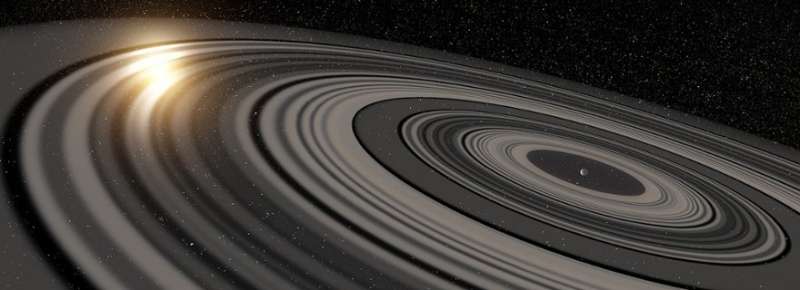Astronomy student searches for giant rings with pictures from 1890

Meticulous analysis of hundreds of photographic plates from the star J1407 between 1890 and 2007 show no stellar eclipses. Robin Mentel, a Master's student at Leiden University, could not detect eclipses of the star J1407 by a planet hypothesized to have giant rings, called J1407b. However, an eclipse may have been missed since the measurement series contains gaps. Mentel's research has been accepted for publication in the journal Astronomy and Astrophysics.
Robin Mentel studied J1407, a sun-like star, 16 million years young at about 460 light-years from Earth in the constellation Centaurus. In 2007, the star showed a strange series of star eclipses. In 2015, a team of researchers, including Mentel's supervisor Matthew Kenworthy, came out with an explanation for those eclipses. A planet, J1407b, with a huge ring system that was more than a hundred times larger than Saturn's ring system, would orbit the star. In 2016, Kenworthy and colleagues showed that the ring system can only really hold on if the rings move against the orbit direction of the planet around the star. And now, in 2018, the Leiden team has shown that in large periods between 1890 and 2007 no star eclipses have taken place.
Two years ago, Mentel, who was still a bachelor's student visiting Leiden from Germany, studied 490 photographic plates with J1407 on it. The oldest records are from the Harvard DASCH survey and date from 1890. There are also records from collections from Bamberg and Sonneberg observatories. Mentel compared the brightness of the star J1407 with two equally bright stars close by on the sky. If the star J1407 was obscured at some point, it would appear to be fainter on the photo than the two nearby stars. Mentel could not detect any eclipses. As an extra check, Mentel compared J1407 with a third star that was just as weak as an eclipsing J1407.
Thanks to these results, the researchers could then calculate how long the period between two eclipses might be. Mentel and his colleagues think that in 2021 or 2024 there may be another star eclipse and so they will have to wait until another eclipse event confirms it. Professional astronomers and amateur astronomers around the world are keeping an eye on the star J1407. If there is an eclipse in 2021, large telescopes can be aimed directly at the star.
In their scientific article, the researchers thank Alison Doane, who died on 29 October 2017. She was the curator of the Harvard Astronomical Plate collection and taught the researchers how to study the plates best. Doane also made sure that in January 2016 61,000 records were saved from a flood of the Harvard College Observatory.
Provided by Leiden University


















